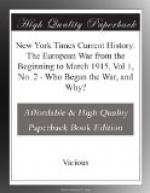The material loss is not the only feature. In the economic struggle in the world markets American and German commercial men have learned mutually to appreciate one another, to appreciate one another more highly than do any other two rivals. The time is long past when the American pictured the German as one of thousands, shut up in a room, surrounded by documents and parchments, speculating about the unknown outside world, and the same is true of the German’s idea of the American—a money-hungry barbarian. Two nations in which so much kindred blood flows and which are connected by so many historical events understand each other better today than formerly. Above all, they have a mutual understanding regarding the ideal in commercial life: A man engaged in work not for the sake of the profit, but for the sake of the work he is doing; one who gives all his strength to his task, and who works for the general welfare of the people as a whole, considering his position as an office and his wealth as an obligation, not as the final aim, but as a basis for the realization of higher attainments. He places the value of character and the development of the creative powers of man higher than all economic success. Two nations united by such common inclinations [pg 272] and ideals, boldness of enterprise, far-sightedness, quickness of decision, and admiration for intellectual achievements, cannot help being exceedingly congenial to each other. What concerns one today concerns the other.
Does it sound like a paradox when I say Germany’s struggle concerns not only her own destiny, but to a considerable extent that of America? Does the United States consider itself entirely immune from the warlike complications brought about by the Servian murder of Princes and Russia’s breach of faith? In any event, it will be difficult for it to say: “What’s Hecuba to me?” One thing should be clearly understood on the shores of the five oceans, that the cause of this most terrible war does not emanate from the dark Balkans, or from a Russian military group, but from envy and hate which healthy, young and striving Germany has aroused in her older rivals; not because this or that demand was made by one Cabinet and refused by another, but because it was believed there was finally an opportunity to destroy the hated opponent who threatened to put the older Western European powers in the shade, and for this reason England and France put their strength into the service of criminal and brutal Servia. The following statistics will, perhaps, throw some light on the development of the foreign trade of the principal countries from 1870 to 1913 (in billions of marks):
1870. 1913. Great Britain 9,180 23,280 France 4,540 12,300 Russia 2,000 5,580 Germany 4,240 20,440
In these forty-three years, which have been decisive in the development of international economy, England, France and Russia have not been able even to increase




